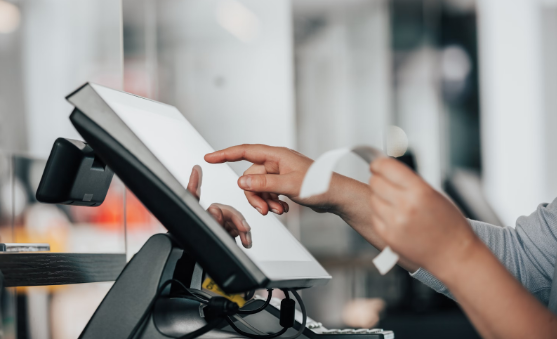Maximizing Revenue in Restaurant Business: Point-of-Sale Systems Explored
Category: How-tos
paymentrestaurant businessrevenue
Revenue is the primary goal of any successful business, including those in the restaurant industry. The restaurant and food service industry is quite profitable. In 2021, the food service industry reached a market value of $2.52 trillion and is expected to reach $4.43 trillion by 2028. However, standing out in the restaurant business can be challenging, with several new food businesses getting established and expanding each year.
Point-of-sale (POS) systems are an excellent way to improve operational efficiency and reduce roadblocks that might hinder your restaurant from achieving its business goals. Let’s explore this industry solution and how it could work for your restaurant.
What are point-of-sale systems?
A point-of-sale or POS system comprises a combination of hardware and software that helps organizations process transactions and manage sales. It records purchases, facilitates transactions, and prints receipts for customers.
There are POS systems specifically designed to meet the needs of the restaurant industry. Aside from facilitating transactions, a restaurant POS system often includes additional features to streamline operations and enhance the dining experience.
Here are some standard features of a restaurant POS system.
- Order management
- Table management
- Menu management
- Reservation management
- Payment processing
- Employee shift management
- Reporting and analytics
The right POS system for your restaurant can significantly help optimize your operations, improve service, and drive profitability.
How Point-of-Sale Systems Increase Restaurant Revenue
Many factors can affect restaurant profitability. Seasonality, location, and the economy can be out of your control. However, other factors like quality of service, efficiency, and menu selections are things you can work on and improve.
A good POS system can help you set up better processes that enhance operations and boost profitability. Here are some of the ways POS systems can increase your revenue.
Ensures accurate payment
Working at a restaurant can be hectic, and sometimes, some orders might slip through the cracks. Your servers might not be able to note an additional side order here and there. While these individual losses may be small, they can add up and affect your overall profits.
A POS system can make it easier to record all customer orders accurately. It efficiently streamlines the payment process and ensures precision and reliability.
Features like bill calculation, check splitting, and integration with multiple payment methods can help minimize transaction errors. As a result, customers have an easier time paying their bills, and you reduce the risk of incurring losses from inaccuracies.
Improves service speed
Time is precious in the restaurant industry, and POS systems can significantly improve service speed.
POS systems allow servers to directly input orders and automatically transmit them to the kitchen. This streamlined system can enhance efficiency, reduce wait times, and improve table turnover rates. As a result, you can serve patrons more quickly and make room for some new ones in a shorter period.
Prevents theft
Restaurants and managers often consider trustworthiness before hiring servers, cashiers, and other restaurant staff. However, there may still be a chance that one or a few employees might be tempted with dishonesty.
Many POS systems have robust security features that minimize theft and unauthorized access. You can set user-specific access levels and implement transaction tracking and monitoring.
The accurate recording of transactions and inventory makes it easier for restaurant owners to monitor possible instances of theft. You can also set up security cameras within your establishment to record visuals of each transaction.
These systems help foster a culture of accountability within your staff, safeguarding your restaurant revenue.
Optimizes your inventory
Effective inventory management is essential for maintaining profitability in the restaurant industry. These resources can be expensive, and any waste can add up and take a hit on your profits.
Some POS systems come with inventory management capabilities. They can provide real-time visibility into stock levels, automated reordering alerts, and detailed analytics on ingredient usage.
This information allows restaurants to optimize inventory levels and minimize waste. Aside from reducing your overhead costs, you can also ensure that you remain well-stocked with popular menu items to maximize revenue potential.
Provides valuable insights
Data has become a highly valuable resource in various business and academic settings, including the restaurant industry. The global data analytics market reached a value of over $31 billion in 2022. Businesses are investing in data and its analysis to achieve different goals.
A POS system can serve as your restaurant’s data repository. It collects information from all your customer transactions and other sources, allowing you to generate comprehensive reports and analytics.
With this information, you can gain a better understanding of various aspects of your business operations. These insights could include sales trends, labor costs, and customer preferences.
As a result, restaurant owners and managers can make better business decisions, such as refining menus, adjusting pricing strategies, and optimizing staffing levels. These improvements make efficient use of your resources and increase profitability.
Boost Your Restaurant’s Profitability
Point-of-sale systems are more than just excellent tools to facilitate restaurant transactions. They can also automate repetitive tasks, manage resources, and optimize workflows to boost revenue and enhance customer satisfaction.
Embracing the unique capabilities of POS systems can help restaurants position themselves for sustainable growth, profitability, and success in a competitive and evolving marketplace.






